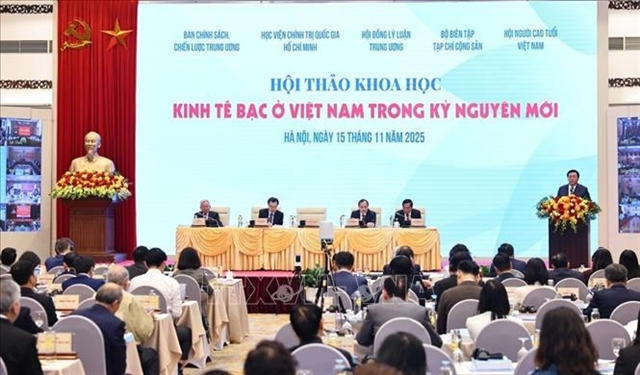 Opinion
Opinion

Minister and Government Office Chairman Mai Tiến Dũng talks to local media regarding the Government’s push towards digital documents and communications ahead of the launch of the National Report Platform

|
| Minister and Government Office Chairman Mai Tiến Dũng. — VNA/VNS Photo |
Minister and Government Office Chairman Mai Tiến Dũng talks to local media regarding the Government’s push towards digital documents and communications ahead of the launch of the National Report Platform
Could you tell us more about e-Government commitments in recent times?
Since the very beginning of this Government’s tenure, one of the top items on the agenda has been administrative reform, including building a robust e-Government.
As per Prime Minister Nguyễn Xuân Phúc’s instruction “think big, look at the big picture, act fast, and start small,” e-Government building efforts at all levels – from ministries to local administrations – have made significant progress, especially in changing the mindset of people, helping achieve a facilitating and transparent Government.
One notable point is that we have established a centralised steering mechanism responsible to address the bottlenecks in the implementation and perfecting of institutions for developing e-Government.
Specifically, the National Committee on E-Government has been established, chaired by the Prime Minister, and there are corresponding committees established in ministries and localities to ensure unified implementation from the central to the local level.
The Government has issued several resolutions on key tasks and measures for e-Government development in 2019-20, with a vision to 2025.
In addition, there are accompanying decrees detailing the implementation of the one-stop-shop, the reporting regime in State agencies and the implementation of administrative procedures in the cyber-environment, or on data management and sharing.
The architectural framework for e-Government 2.0, developed by the Ministry of Information and Communications, has also been submitted to the Government for implementation.
The Prime Minister has issued decisions on sending and receiving electronic documents between agencies in the administrative system, and on electronic identifications of agencies to be used in the connection and sharing of data between ministries, sectors, localities; and approved the national digital transformation programme towards 2025, with a vision to 2030.
What can you tell us about some of the foundational platforms of e-Government that have been put into operation?
Since 2019, many important information systems and platforms have been put into work, helping change the mindset of State agencies from traditional paper-based working to digital documentation.
The National E-Document Exchange Platform has connected to 100 per cent of ministries, local governments and other organisations. This is an important platform for promoting the sending and receiving of information and data on digital documents, reporting regimes and public administrative services on the internet.
So far, 2.2 million documents have been sent and received on the system. The system is expected to help save more than VNĐ1.2 trillion (US$52.17 million) each year.
The information system for Government sessions (e-Cabinet) is aimed at renovating the working method towards a paperless Government. The system has served 20 conferences and sessions of the Government and processed more than 470 votes from Government members, replacing printing and issuing more than 200,000 paper documents. This system helps save about VNĐ169 billion a year.
The National Public Service Portal since its launch at the end of 2019 has made significant contributions to enhancing transparency and facilitating access to and implementation of administrative procedures no matter the time or administrative borders, strengthened monitoring and evaluation activities, and promoted discipline while preventing risks of corruption.
After eight months, the portal has connected with 18 ministries and agencies, all 63 localities in the country, and eight banks or other e-wallet service providers. It has registered the 1,000 services to be online recently, and logged more than 56.4 million accesses, more than 14 million documents synced and 260,000 processed online.
The portal helps save VNĐ6.7 trillion a year.
On August 19, the National Reporting Platform will be launched and is expected to help improve IT integration in the synthesising and reporting, promote decision-making and governance based on digital data that are updated in real-time and displayed in visually engaging manners.
These outcomes are the results of political determination, unanimity of direction and adherence to goals set by the Government and the Prime Minister, which motivates ministries, sectors and localities, as well as IT businesses and the people to engage in these efforts.
What are the expected impacts of the National Reporting Platform?
I believe the implementation of the National Reporting Platform and the Centre for Information and Directions from the Government and Prime Minister will follow the successes of previous efforts in e-Government.
The National Reporting Platform is built based on the previously launched Government Reporting Platform, enhanced by connections to reporting platforms of ministries and local governments, which will help streamline and share data reports from all State agencies, and help ease the making of reports which inform decision-making processes with visuals and charts and capacity to deliver in-depth forecasts.
The platform will also help the Government monitor the progress of socio-economic goals set by the parliament, or tasks the central Government assigned to localities or ministries.
So far, 16 ministries and State agencies have connected to the system, 20 reporting regimes and 61 out of 200 socio-economic objectives are online. The move to a digital system will help save on the use of physical documents by about VNĐ460 billion a year.
Instead of submitting and receiving monthly, quarterly, six-month, annual reports or other unplanned reports on paper, now ministries and local agencies can input the information in real-time. Via the platform, the leaders of Government and ministries can see very clearly the socio-economic situation or other matters of interests at any given time, which will help deliver better decisions on issues of interest to businesses and people.
However, the opening of the platform and the centre is just the first step of the process of renewing working methods and promoting digital transformation in the management activities of State agencies.
Many short-term and long-term tasks need to be performed, requiring drastic and in-sync participation of ministries, sectors and localities, especially with regards to updating data and enriching information in the socio-economic database for management and governance. ——VNS




